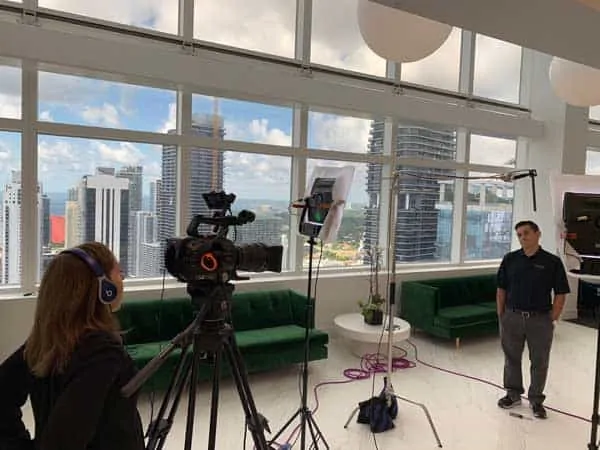Marketing Videos for Sales
Marketing drives sales. Sales drives the rest of the business. But how do you use marketing videos for sales funnels and enhance your sales process? This post will share how you can create videos for the entire sales funnel and which videos will become the most important for your business.
Most marketing includes several components to maximize the dollar spend. Marketing can often include several touch points based on the target market, potential customers, what types and where products are sold. We have all seen marketing in the form of print, digital, and several other forms, but all of it should depend on the marketing mix and marketing funnel being used. It won’t come to a surprise to anyone that we would recommend using video in every step of your sales process.
A lot of people think video should be used at the top of the funnel…during the phase often described as the interest or discovery portion of the sales process. We believe it should be used as a tool along the sales process to maximize the relationship and court the prospect until the sale (and even afterward).
According to Vidyard there are general rules of thumb when it comes to where to place video content. They share that only 15% of your video content should be targeted to prospects and drawing them closer to the sale. The concept is that you should be targeting your customers according to their needs and wants, therefore, if you’re strategic in selecting where you’re placing the ad, you’ll find much better results. Less is better here (in terms of quantity of videos).
What is Top of Funnel Content?
Bringing in prospects can be tricky, but placing video topics that are broad in nature, that have a more mass attraction can attract the right client. At this stage, it’s important for the tone to be more authentic in nature and isn’t too sales focused. It should come across as informative and helpful, with you as the solution. Some ideas might include:
- Frequently Asked Questions/How-To Content – Show off your knowledge and answer requests from your network to attract clients like who you work with now. If you’re receiving a large volume of questions that are common every time you start working with a client, this might be a strong video topic. Placing this on your website, social media, YouTube channel, etc. will help you attract those who want to speak with someone who solves their problem.
- Webinar Content – If you conduct webinars, consider recording them and sharing them online. It not only shares your knowledge, but also illustrates your ability to answer questions and solve problems.
- Interviews/Speaking Engagements – If you or your leadership team has been interviewed or spoken publicly, capture that to maximize the value of their expertise. You can also stage “chats” or one-on-one interviews to create the perfect content.
Above is an example of a Frequently Asked Question Video.
Marketing Videos for Sales Funnels: Evaluation Stage
When prospects get past the initial exploration stage and start to dig a little deeper into who you are and what you do, it’s time to give them information that helps them take next steps. For example, at this stage you’ll need to begin sharing testimonials and case studies to help the prospect know what you do, how you helped other clients, and improve your odds of getting a call. If your business sells a product or service that needs to be shown to be understood, it might be time to show a demonstration, product, or service video. These can often be used in your social media marketing plan in any retargeting efforts. If you get a large volume of requests for more information during this phase, you’ll likely be getting an increase in sales because of it.
At this phase, you can also schedule one-on-one calls or meetings to discuss any additional questions they have. Prior to your meeting/call, consider sending them a personalized video via email that defines what your meeting will be about and what they can expect at the end of the meeting. If you haven’t been able to line up a meeting (or cannot), this is also the best time to introduce an email capture point. This is the point where you know they have interest and may want to learn more from you. Plus, if you’ve been able to track their video watch data leading to this point, you’ll have a good idea about who they are, what they need and how to continue to market to them. This will begin to feed into your marketing research that will ultimately feed into your marketing strategy.
Here’s an example of a fun Testimonial Video.
Marketing Videos for Bottom of Sales Funnel
This is the time to reinforce what they’ve learned so far and help them make the final step…a call to action. Obviously, you’ll want a call to action along the way, but there also comes a time that you must blatantly state, “This is the time you should buy.” Videos at this stage might include:
- Campaign video – Nurture them to decide to choose you. Time it right and you’ll get the call/sale.
- More Frequently Asked Questions videos are perfect at this point.
- Follow Up Videos – You’ve had the call/meeting, you’ve done what you can, now you might consider a follow up video. Make it comical to keep it light-hearted and less serious. Less pressure on the prospect is usually better than a high-pressure message (contrary to what you might think).
Above is a video that reinforces what a company has done for others…a video that might be shared after an initial exploratory meeting.
Keep in mind, marketing is the process of getting prospects to notice you and ultimately act. If you have a well-defined marketing plan and institute a current version of the Ps of marketing, you can guide your prospect to a landing page and make a sale. Special note, you might think that product price affects your marketing mix, and it does…but it shouldn’t affect your ability to make the sale. Keep in mind, if your prospect knows what problem you solve, how you do it, and that others have been very happy with your results, you can sometimes charge a premium for your product or service. On the other hand, if they can’t understand or see that value, it will be tough to sell at a premium and product price will impact your ability to make the sale.
Related Posts:
How to Generate Sales Leads with Video
Manufacturer Product Marketing Videos & Increased Sales
SOURCE: https://www.vidyard.com/blog/create-video-marketing-for-the-sales-funnel/























